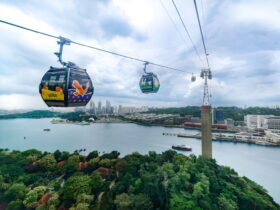During our art walk with OH! Potong Pasir, we discovered several interesting things about the sleepy neighbourhood
By Pamela Chow

Up till when I embarked on an art walk of the nondescript neighbourhood, my closest interaction with Potong Pasir was only to pass it by en route to Serangoon or Kovan.
OH! Open House, the group which organises annual tours through the heartlands, often lead guided tours to places usually off-limits to the public, like schools and residents’ homes.
Here are the five surprise finds I discovered along my journey:

1. How to appreciate the iconic “ski slope” blocks
One standout feature of Potong Pasir is the sloping architecture of HDB (or Housing Development Board) flats, which I hadn’t noticed before. Since the 1980s, these blocks made up Potong Pasir’s iconic skyline.
When we started, I was greeted by Block 142, which had an inviting “Welcome to Potong Pasir” printed on it. Strangely, seeing this greeting made me more eager to begin the tour.
From ground-up, these slanted roofs look interesting; but if you head higher and bring the roofs to eye level, they also seem have have a whimsical quality about them.

The tour even brought us into a two-storey home built under one of these slanted roofs. Due to the architecture of such blocks, you have to access these units via a different flight of stairs, and they have a ‘private’ lift lobby beside the balcony.

2. Singaporeans can be very generous
Though you can certainly walk around Potong Pasir yourself, what I loved was being able to catch glimpses into the daily lives of my countrymen.
During this tour, I was amazed at how generous Singaporeans can be. They opened their homes to be visited by hundreds of strangers, let the crew borrow personal items and even allowed artists to install artworks in their living space.

This is Uncle Lee, who has been living in Potong Pasir since 1984. We were told by our guide that we weren’t allowed to enter his home, but when we arrived, Uncle Lee merrily welcomed us and invited us in.
When we asked if the guzheng (above) was his, he laughed and told us, “It’s ‘theirs’.” Throughout the walk, participants are encouraged to spot out-of-place items that have been transferred from other homes on the tour, and identify which homes they were taken from.

Uncle Lee even lent some of his precious belongings (above), such as a document signed by former Member of Parliament Chiam See Tong, to be displayed in a ‘treasure chest’ outside.

In another home, the living room has been painted over to resemble tarpaulin, a common sight in Potong Pasir nowadays as it undergoes redevelopment and construction works.

3. Where the name “Potong Pasir” came from
From 1910 to 1937, Potong Pasir was dominated by sand quarries, hence its present name, which means “cut sand” in Malay.
In this town, one gets the impression of an old Singapore frozen in time. While its kampong settlements have been replaced by government flats, the community still retains a semblance of the fabled “kampong spirit”.
Steeped in historical tales that have left marks still visible today, Potong Pasir has a rich past full of untold stories.

4. Art works are available for free viewing
Even if you have no plans to join an OH! Potong Pasir tour, you can still visit seven public community projects around the town, available until Mar 27.
Simply grab a pamphlet guide from the OH! Open House booth at Blk 142 and be on your way. Here are two projects that participants of the art walk will pass by:

At Blk 102, you can “come play” on old-school hopscotch grids inspired by Potong Pasir’s history. The Chinese characters painted onto the pillars (above) read “come” (top) and “play”.

The carpark lot by Blk 139 used to be a landmark street soccer court, which was relocated due to complaints about the noise. Here, you can see and hear (yes, hear) the scavenged rubble of its colourful floors come back to life.

5. There is one lone gravestone left at Bidadari Cemetery
Bidadari Cemetery was exhumed in 2001 to give way to new housing estates, and the Bidadari Memorial Garden was developed, preserving 21 headstones from the original cemetery.
However, one lone gravestone still lies at the grass field where Bidadari Cemetery used to be.
This white marble slab, emblazoned with a cross, used to belong to a family of graves. There is no indication of who laid there, or why it was left behind.
Scouring through the field, I was unable to locate this headstone. However, if you’re curious, you can join a Ghostwriting session at the OH! Open House Bidadari stop. Depending on which session you choose, you will perform a short narrative within Bidadari; I understand from a crew member that one of the sessions will bring you to visit the lone grave.
Are you curious to find out what else Potong Pasir is hiding? Look out for our Kaypoh Korner feature coming up in our Apr 1 issue of Weekender!
OH! Potong Pasir is running every weekend until Mar 27, with walks starting at $25. More information here.
Weekender would like to thank OH! Open House for hosting our writer.
ADVERTISEMENTS










2 Comments